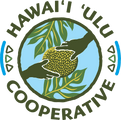Welcoming Kū with a Kaʻau of ʻUlu Trees
The seasonal transition from Lono, akua (god) of fertility and rain, to Kū, akua of farming, fishing, and politics, marks the end of the Makahiki season. The four-month Makahiki begins with the first sighting of Makaliʻi (the constellation Pleiades) in late October or early November on the horizon at sunset and marks the start of the traditional new year in Hawaiʻi. Historically, the Makahiki was a time to let the ʻāina (land) rest and be softened by rain in preparation for the new planting season. It was also a time to refrain from war and an opportunity for the aliʻi (chiefs) to join with the makaʻāinana (commonors) in feasting and games.

This year, we were honored to celebrate the end of Makahiki season with the Hawaiian Cultural Center of Hāmākua (HHCOH) and to contribute forty (1 kaʻau) ʻulu trees to help establish a new community grove at the Hāmākua Harvest Farmers Market site in Honokaʻa, Hawaiʻi Island. When Makaliʻi begins to come up at sunrise and is no longer visible at night, it is time to send Lono back to the ancestral lands of Kahiki until the next Makahiki and to welcome back Kū, who has multiple kino lau (bodyforms), including the ʻulu (breadfruit). According to Lanakila Mangauil, Executive Director of HCCOH, “Kū season is when the days get long and things start to grow tall and straight” – like ʻulu.

This year’s ceremony began at Pelekāne bay below Pu’ukoholā Heiau in Kawaihae and included hula, chanting, prayers and an ʻawa ceremony – where each keiki ʻulu tree was fed to set the good intention of growth and abundance before planting. Just before sunset, a waʻa (canoe) sailed from shore carrying a kiʻi of Lono and returned with a kiʻi of Kū at the helm, draped in red – his color. HCCOH has been holding this ceremony in Kawaihae annually since 2015 to bring people back into balance by recognizing the beneficial strengths of Kū, including healthier forms of conflict resolution, such as "Kapu Aloha" – a traditionally-grounded perspective to non-violent direct action activism today. In fact, it was this first ceremony seven years ago that launched the “mauna movement” to halt construction of TMT on Mauna Kea and paved the way for the 2019 uprising whose potency and effectiveness is now viewed as a historical accomplishment for indigenous rights globally.

The next morning at Hāmākua Harvest, 40 ʻulu trees were planted by dozens of community hands. Those who participated made a commitment to come back and care for their tree to ensure it will yield abundance – not only for them but for the community as a whole, and for the lives that will come after them. ʻUlu trees typically bear fruit for 60 or more years and can yield over 500 pounds of nutritious fruit per year, providing nourishment for generations to come.

To contribute to HCCOH or volunteer for an upcoming work day at Hāmākua Harvest, please visit their schedule online: https://hccoh.org/.
Looking for more breadfruit in your life, or have never tried it before? Check out our selection of products on our online store.


Leave a comment
Please note, comments must be approved before they are published